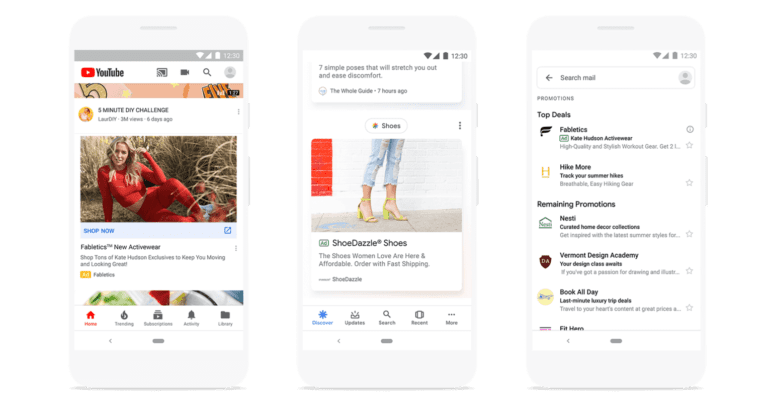Do you remember what you were doing one year ago? It was a simpler time – the Toronto Raptors were in the midst of an NBA championship run, activists were gearing up to storm Area 51, and a little diddy called “Old Town Road” was burning up the airwaves. You may also remember May 2019 for Google announcing the availability of “Discovery Campaigns”, which were subsequently rolled out to advertisers throughout the year. If you have not yet experimented with Discovery Campaigns, you should strongly consider doing so. My experience has convinced me that they can be a powerful tool, especially for expanding a remarketing strategy.
Discovery Campaigns: What Are They?
If you have not yet discovered* the campaign type, here’s what you need to know. Discovery Campaigns can show ads on three placements – Youtube, Gmail, and Google’s Discovery Feed. Google’s Discovery feed, for the uninitiated, is a feed that shows on the Google App and the Google mobile home page that shows stories and links based on a user’s interests.
In terms of how the ads appear, they are similar in many respects to Google’s responsive display ads. They take an input of several images, a logo, and headlines, and combines those for different placements. They can show as a carousel-type ad, allowing users to scroll through different images and headline pairings. Here’s are a few examples of how they might appear on different placements:

Discovery Vs. The Google Display Network
In order to test this new campaign type in one of my accounts I created a Discovery Campaign targeting a remarketing list and enabled it to run at the same time as the previously created display remarketing campaign. The account in question was a real estate advertiser with the goal of generating leads. Prior to discussing the results of this campaign, I wanted to highlight a few aspects of the experiment:
- Both campaigns were set to the “Maximize Conversions” bid strategy.
- The campaigns both ran for 85 days.
- The campaigns ran with different creative, as the campaign on the GoogleDisplay Network utilized professionally designed creative assets and the Discovery Campaign running a selection of photographs.
- The campaigns were run concurrently but were not set up as a true A/B split test. Experiments are set at the campaign level, so it’s not possible to A/B test different campaign types. Consequently, it’s possible that some users were exposed to both the campaign on the Google Display Network and on the Discovery Campaign placements.
Even with those limitations, the results were stark enough that they inform my assumptions about the different campaign types moving forward. Those results are presented in the data below.

The major differences between the two campaigns can be boiled down to the number of impressions and click-through-rate. The Display Campaign dwarves the discovery campaign in terms of the number of impressions, generating more than 25x their number. Note: if you’re wondering (as I am) about the relative average frequency between the two campaigns, that metric is not yet available for Discovery Campaigns.
Even with that huge difference in the number of impressions, though, the Discovery Campaign had more clicks attributed to it than the Display Campaign, driven by its relatively high click-through-rate. This lines up pretty closely to my prior beliefs about the two campaign types, given that a native ad format on a high-engagement stream should induce more clicks than an ad on the display network.
One important caveat that deserves mentioning when evaluating the performance of Discovery Campaigns is that initial Gmail ad expansion is reported as a click. Google will be removing those engagements from the “click” column beginning July 1, 2020, but for the time being understand that clicks do not necessarily correspond to website activity. Until then, tracking campaign performance in Google Analytics or another website tracking/reporting platform may be necessary to fully understand the traffic generated by Discovery Campaigns.
That caveat aside, what can be said about the quality of the traffic? Here too the Discovery Campaign seems to best the Display Campaign. The traffic from the Display Campaign had an average bounce rate of 86% and a paltry 1.2 pages/session, while the Discovery Campaign had averages of 35% and 3.93 pages/session. Additionally, the Discovery Campaign had two conversions attributed to it while the Display Campaign had just one, though at that sample size I don’t put a lot of stock in that differential.
What to make of these results? I think they tell a pretty coherent story that can be generalized to other Display/Discovery Campaigns. The Display Campaign swamps the Discovery Campaign in terms of the number of impressions available on the network, but the placements and ad format of the Discovery Campaign support a much more engaged audience. That level of engagement supports a better click-through-rate and more engagement on the site itself. Whether one campaign type is preferable to the other depends on your goals: If you believe that impressions have value in and of themselves then advertising on the GDN is much more cost-effective. If, on the other hand, your goal is to drive quality website traffic, then a Discovery Campaign may be preferable.
That said, in many cases, I think that this needn’t be a “one or the other” situation. Like Lil’ Nas X and Billy Ray Cyrus, Discovery Campaigns and Display Campaigns can be complimentary of each other, especially if you seek to reach your remarketing audience as much as possible. So, while you may not be able to turn the clock back to 2019, it’s not too late to start experimenting with Discovery Campaigns. And testing them with your remarketing lists is a great place to start.
Looking for more remarketing strategy tips? Check out our Ultimate Guide To Google Ads Remarketing.
*Pun intended, unfortunately.




